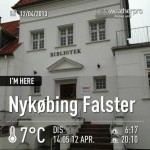DISCOVER:
All smartphones and tablet devices have a camera fitted.
- Explore your device to take a photograph and then locate the camera roll or gallery via the menu.
- Mobile devices make it very easy to share photographs by email, messaging and twitter. Take a photograph of a sign with the name of your library or museum, open your Twitter app, attach the photo and tweet it with a short message and the hashtag #23mobilethings
- You can also take a screen shot on your device [iOS | Android]
EXPLORE:
There are many different types of photography apps you can add to your mobile device. Some offer filters to enhance the look of your photos, most will interact with other social media tools (eg. sharing via Twitter or Facebook) while others are part of their own social networks (eg. Instagram, Snapchat)
- Try out Instagram (you can also have fun with Instaweather, and Instastitch). Instagram has its own ‘jargon / language’ for example people who use Istagram refer to themselves as #igers and they often share photographs of themselves known as #selfies . Take a photograph and upload it with the #23mobilethings hashtag. Explore the other photographs that have the same hashtag.
- Try out an app with filters eg Hipstamatic (or others like Snapseed, SquareReady Pro and ProCamera)
- If you have a Flickr account you can upload photographs as you take them via the Flickr app (no iPad version is available use the iPhone version)
- Snapchat is a very popular photography app with many teenagers they use it as a social network to communicate with friends. iOS and Android app that allows users to send photos among their contacts, which automatically delete after a short period of time (between 1 – 10 seconds)
- There are more useful Photography links on our Pinterest Board.
THINKING POINTS:
- How could your library use photographs to promote library services, events and activities?
- Does your library Twitter account use Instaweather to provide a daily update?
- Do you have a permission form available so that when you take photographs of clients or events you have their agreement for those images to be used and shared online?
- How easy is it for clients to contribute digital photographs to your library collection (eg. local history)?
- Could you use photography in library programming (eg. how-to classes or competitions)?
- The Getty Museum celebrates the Instagram photographs taken by museum visitors by adding them to their Insta-Getty Pinterest board

